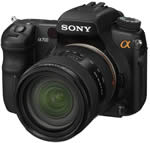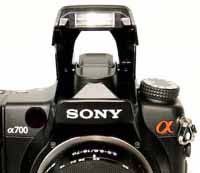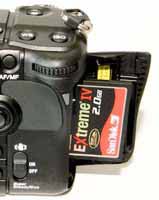Sony A700 Review
Review Date: January 17th 2008
Author: Mark Goldstein
Leave a comment about this Review
|
Introduction

The Sony A700 is the second DSLR camera from Sony, a more complex model than the original A100 that is aimed at the prosumer photographer. The Sony A700 bears more than a passing resemblance to the Konica Minolta Maxxum / Dynax 7D DSLR, which is perhaps no surprise given that Sony effectively inherited Konica Minolta's camera business a couple of years ago. The list of brand new features is certainly impressive. There's a 12.24 megapixel CMOS sensor, replacing the 10 megapixel CCD sensor of the A100, a 11 point autofocus system, extensive ISO range of 100-6400, 5fps continuous shooting (up to 17 shots in RAW mode), a fantastic, high resolution 3 inch LCD screen, magnesium body with dust/moisture resistant seals and a fastest shutter speed of 1/8000th. The A700 builds on the existing Maxxum / Dynax lens mount with the re-christened Alpha mount, with the majority of Konica Minolta lenses being supported. As with the A100, the new A700 incorporates several Konica Minolta technologies, most notably an anti-shake system that's built into the camera body, and the eye-start auto-focus system which makes the camera continuously focus when you hold the viewfinder up to your eye. The Sony A700 also inherits the anti-dust system, Dynamic Range Optimiser and Bionz Image Processor from the A100, although all of then have been significantly upgraded. The Sony A700 is taking on the Nikon D300, Canon EOS 40D and Olympus E-3, all excellent cameras in their own right. Mark Goldstein took the A700 all the way to Dubai to find out if it can beat the competition.
Compare Prices
Support PhotographyBLOG: Buy the Sony A700 from one of our affiliate retailers:Ease of Use
The Sony A700 is an attempt to build on the success of the entry-level A100 model and take a slice of the mid-range, prosumer DSLR market. Sony may have shocked industry watchers with its wholesale buy out of Konica Minolta at the start of 2006 � in order to play catch up and quickly narrow the gap � but it obviously saw something of value and that latter company's innovations sensibly haven't been forgotten. The A700 visibly pays respect to Konica Minolta's heritage, resembling the Dynax/Maxxum 7D in looks and features, and perhaps most importantly by keeping the Minolta A-type lens mount (now of course the Alpha mount) it's cleverly afforded compatibility with a wealth of existing lenses. It's the first sub-�1000 model to boast a 12 megapixel chip (a resolution now matched by subsequent releases from its competitors), which is an APS-C size CMOS sensor.
As you'd expect, the A700 is a bigger, heavier and better-built camera than the cheaper A100 model. On its own the Sony A700 body weighs nearly 700g and measures 141.7 x 104.8 x 79.7mm, rather dwarfing the standard 18-70mm f/3.5-5.6 kit lens, which feels distinctly lightweight and out-of-place in this company. Build quality is excellent, with a chunky magnesium alloy body and aluminum chassis that is well-suited to two-handed operation, unlike some of the more diminutive DSLRs that we've seen recently. The body is weather-sealed to protect it against dust and water, although it's important to note that this doesn't make the A700 a true water- or dust-proof camera. The A700's design is dominated by the very deep, chunky rubberised handgrip, and the large 3 inch LCD screen on the rear (more on that later). There is a pronounced curve/indentation to the back of the body, allowing a comfortable resting position for the thumb when gripping the camera, while the indentations on the rubberized front of the grip � which houses both card (at the side) and chunky info lithium NP-FM55H battery (at the base) � means that it won't easily slip from your grasp in the heat of the action.
As this is a DSLR, no memory card is included with the camera itself. There are two available slots, one for CompactFlash and the other for Sony's Memory Stick Duo, although I'm not sure how many photographers will actually use the more expensive Sony format. Still, at least you have the choice. For the purposes of my review, I was shooting to an 8GB compact flash card with a mixture of RAW, simultaneous RAW+JPEG and, for sample images, the new Extra Fine JPEG mode. Pleasingly, write speeds for the different file formats appear nigh on instantaneous, meaning that in single shot mode you're not conscious of the camera processing the first image before you can take the second.
As with the older A100, the Sony A700 has inherited a number of core Konica Minolta technologies. In addition to the aforementioned lens mount that boasts day one compatibility with a host of existing lenses, Konica Minolta's pioneering Anti Shake technology, whereby optical image stabilisation is built into the camera body itself rather than the lens, has also been adopted. Here it's called Super SteadyShot, and it does much the same thing: adjusting for external hand-wobble by counter-moving the CCD in a compensating manner. I found during the review period that although it's quite effective, resulting in more usable shots in low light conditions without flash than I thought possible, it certainly doesn't give the 4 shutter speed steps advantage that the marketing literature promises. Sony's system does offer a large advantage over the likes of Nikon and Canon, in that because it's built-into the camera body, it works with any lens that you attach to the camera, removing the need to buy more expensive lenses with anti-shake. On the other hand, Super SteadyShot on the A700 isn't as effective as similar systems from Olympus and Panasonic, which are also built into the camera body.
Finally, at the point of powering down, the A700's sensor vibrates to automatically shake off any dust that has found its way in when changing lenses or zooming in and out. As a further line of defence, the CMOS sensor's filter sports an anti-static coating. In the short term the anti-dust combo appears to work well � my trip to the deserts of Dubai didn't cause any additional dust to appear, although the review unit did already have an annoyingly large blob of dust which refused to budge. Therefore, in spite of the Anti-Dust Technology, you'll still need to invest in some kind of third-party sensor cleaning solution to keep the image sensor completely free of unwanted dust.
 |
 |
| Pop-up Flash | Main Menu |
The Sony A700 is quite complex in terms of the number of external controls that it has, with over 20 in total. The majority of the controls are clearly labeled and common to most cameras. There's a mode dial on the top-left of the camera that lets you quickly select the various shooting and scene modes. The MR (Memory Recall) option essentially allows you to configure the camera in up to three different ways and then quickly choose one of the custom modes. Also found on top of the camera are the Drive continuous shooting/bracketing button, white balance button, very handy ISO and Exposure Compensation buttons, and the shutter button, which is quite loud compared with other DSLRs and may deter some from using it for candids, but at least its definitive sound confirms for the less experienced user that the shot has actually been taken.
The A700 can shoot in continuous mode at a very respectable maximum of five frames per second, and the number of continuous sequential shots possible is limited only by the available memory when shooting Standard or Fine JPEG. Even when using RAW mode, the A700 maintains 5fp for up to 17 images - very impressive. The Drive button also allows exposure bracketing of +/- 0.3EV, +/- 0.5EV, or +/- 0.7EV, shooting three or five images with a single press of the shutter. It also takes three bracketed images for white balance and dynamic range. Notable by its absence is any kind of LCD panel on top of the camera to show what the current settings are, which is always useful. Instead you have to rely on the information displayed in the optical viewfinder or the more comprehensive information shown by default on the LCD screen. Finally, the pop-up flash housing has to be opened by hand, and there's also an external flashgun hotshoe which includes a slip off plastic cover.
The XtraFine LCD screen is a large 3 inch model with an amazing resolution of 921,000 pixels (most "standard" screens have 230,000 pixels), a wide viewing angle and visibility that isn't compromised by bright sun. This screen is very similar to the one used on the Sony DSC-G1 compact camera. The LCD on the A700 is a joy to use, one of the best that I've ever seen on any digital camera. With a staggering 921,000 pixels, it provides a 4x increase in resolution compared to most competitors, resulting in a buttery smooth, grain-free image that is well-suited to showing off your photos to friends and family. It also usefully displays and allows you to change essential shooting information in the absence of a second LCD control panel window on top of the camera.
Inset above the LCD is the equally bright and clear optical pentaprism viewfinder, surrounded by a spongy rubber eyepiece and with a tiny dioptric adjustment control ranged top right. The viewfinder displays standard shooting information along the bottom, with a central grid that illuminates in red which of the 11 point AF areas are being utilized. Beneath the viewfinder is a sensor that pre-focuses a shot as you bring your eye up to it (called Eye Start AF); a real boon for the happy snapper brigade, although you can turn this off if you don't get on with it. The newly developed 11 point autofocus system with a large f2.8 sensor is occasionally confused by busy scenes, but results in far fewer missed shots than with the A100. The handy AF/MF button to the right of the viewfinder lets you switch seamlessly between auto and manual focusing.
 |
 |
| Rear Controls | Top Controls |
Logically placed to the left of the optical viewfinder on the camera back is the Off/On switch. Flick it to on with your eye already to the viewfinder and you're ready to take the first shot in less than a second. Arranged in a vertical row immediately below are four buttons for bringing up the camera's menu folders on screen; activating, switching off or changing the view of the display settings; the last two being the self explanatory trash can and playback buttons. On the opposite side of the main LCD screen is a responsive four-way control joystick for tabbing through and affecting change to settings or images. Below the joystick is a histogram graphic, which can be called up in playback mode to reveal the areas of brightness across an image and some basic information about the settings used. The same button allows you to select from the 7 new Creative Styles, which are a logical expansion of the A100's colour modes function. The available styles include Standard, Vivid, Neutral and Adobe RGB, plus three customisable memory settings for quick setup for subjects like portraits or landscapes. Furthermore, you can alter all of the various image parameters for each style, effectively allowing you to fine-tune the A700 to suit your particular needs.
Below the Histogram / Creative Styles is a button that rotates captured landscapes to portrait ratio and vice versa. Tilt the camera on its side and the shooting info on the LCD automatically rotates through 90� with you. The same button doubles up as the Function button, which provides quick access to most of the principal creative controls via the LCD screen. Press it once and the screen switches to Quick Navigation mode, allowing you to use the joystick to move around and change the various settings shown on the LCD, including image size, image quality, ISO speed, white balance and flash settings, amongst other things. It's an excellent system that works really well, almost making up for the lack of a top LCD information screen. You can still access all of these options from the main menu system or a dedicated button too.
If the A700 is set to Manual shooting mode, aperture is set via the rear control dial, with the control dial near the shutter button controlling the shutter speed. In aperture- and shutter-priority modes, either dial can be used to set the aperture and shutter speed respectively. The behaviour of these dials can also be customised to suit your working style. Completing the rear controls is the large Super SteadyShot on/off switch, which like the main power switch requires a reassuringly firm flick of the thumb, meaning that accidental activation or deactivation isn't a problem. The AEL button locks the exposure in capture mode, and in playback toggles between showing 9 thumbnails or the fullscreen image. Holding down the AEL button with flash activated allows on-the-fly access to slow sync shooting. Around the AEL button is a switch (again quite firm to rotate) that selects one of the three exposure modes.
On the left-hand side of the camera body sit 4 rubber flaps, covering ports for the flash sync cable, a remote release cable, a DC-in port for a mains power adaptor, and HDMI and Video Out ports. HDMI is a new addition that provides direct HDMI output to a Bravia HDTV or other compatible HDTV screens. You can choose between standard 3:2 and widescreen 16:9 aspect ratio. With some of the newer new Bravia TVs, images are automatically optimized in sharpness, gradation and color reproduction for HD display. Unfortunately Sony didn't supply us with a suitable Bravia TV to test this out! There is a multi-function wireless remote control supplied in the box to control TV playback and also fire the shutter remotely.
 |
 |
| Memory Card Slot | Battery Compartment |
Sony's D-Range (Dynamic Range) Optimiser adjusts brightness or contrast across the whole scene and is claimed to be particularly effective for high contrast, backlit scenes. When shooting in either JPEG or RAW, the Standard mode improves shadow detail using standard gamma curves. Advanced Auto mode allows you to select one of five correction levels, and DRO bracketing automatically takes three shots at different DRO levels with a single shutter press. Take a look at the Image Quality page for some examples of the various DRO settings.
The main camera menu system on the Sony A700 is accessed by pressing the Menu button on the rear of the camera. As expected from a Sony digital camera, these are cleanly and logically structured. There are four main menus, Camera, Custom, Play and Setup. All of the camera's main options, such as white balance, image quality, auto-focus mode and ISO speed, can be accessed here, so the Camera menu has 21 options spread over 4 screens, the Custom menu also has 21 options, the Play menu 9 and the Setup menu 19. Due to the large LCD screen and restricting the number of on-screen choices to seven, the various options and icons are clear and legible. If you have never used a digital camera before, or you're upgrading from a more basic model, reading the easy-to-follow manual before you start is a good idea. Thankfully Sony have chosen to supply it in printed format, rather than as a PDF on a CD, so you can also carry it with you.
Once you have captured a photo, the Sony A700 has an average range of options when it comes to playing, reviewing and managing your images. You can instantly scroll through the images that you have taken, view thumbnails, zoom in and out up to 13x magnification, view slideshows, delete, protect, rotate an image and set the print order. The Display button toggles between a simple settings information screen, no information and five small thumbnails above the main image. The Histogram button a combination of brightness and RGB histograms, small image and key camera settings.
In summary the Sony A700 achieves the remarkable feat of offering lots of complex features whilst being relatively simple to use. Indeed, the A700 is one of the most well-designed and intuitive DSLR cameras that I've reviewed, with everything falling to hand, and generally responding to user input immediately. High praise for overall ease of use then, but what about the image quality?
|
![]() PhotographyBLOG
is a member of the DIWA
organisation. Our test results for the Sony A700 have been submitted to DIWA
for comparison with test results for different samples of
the same camera model supplied by other DIWA
member sites.
PhotographyBLOG
is a member of the DIWA
organisation. Our test results for the Sony A700 have been submitted to DIWA
for comparison with test results for different samples of
the same camera model supplied by other DIWA
member sites.
